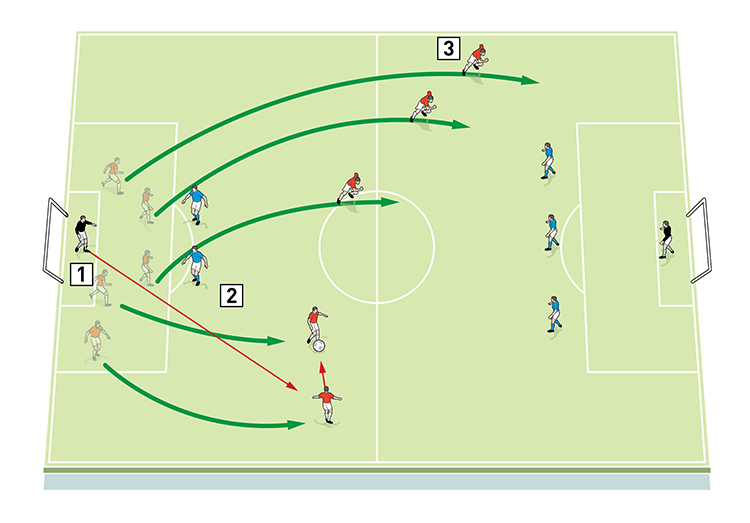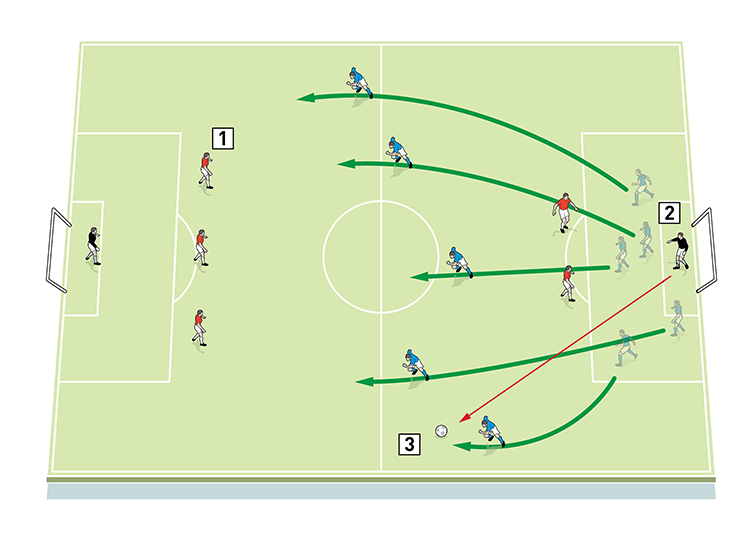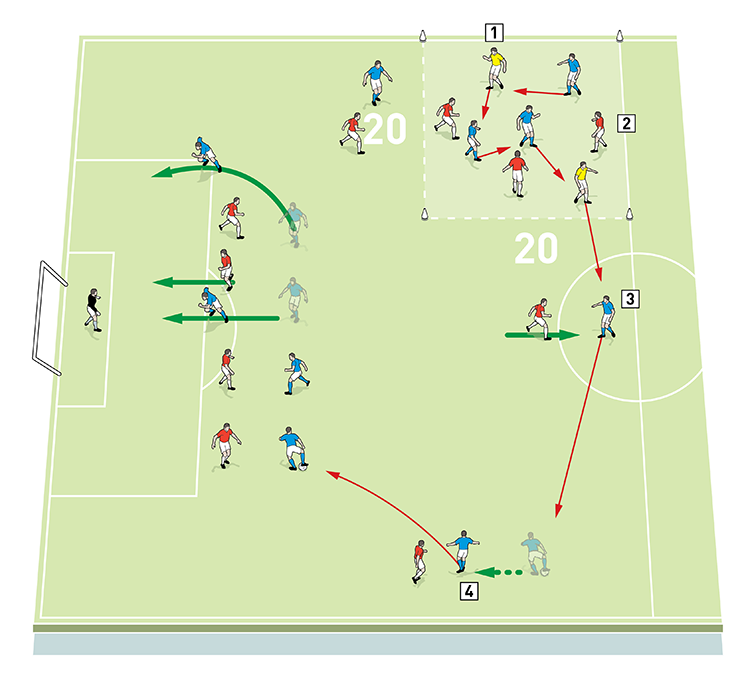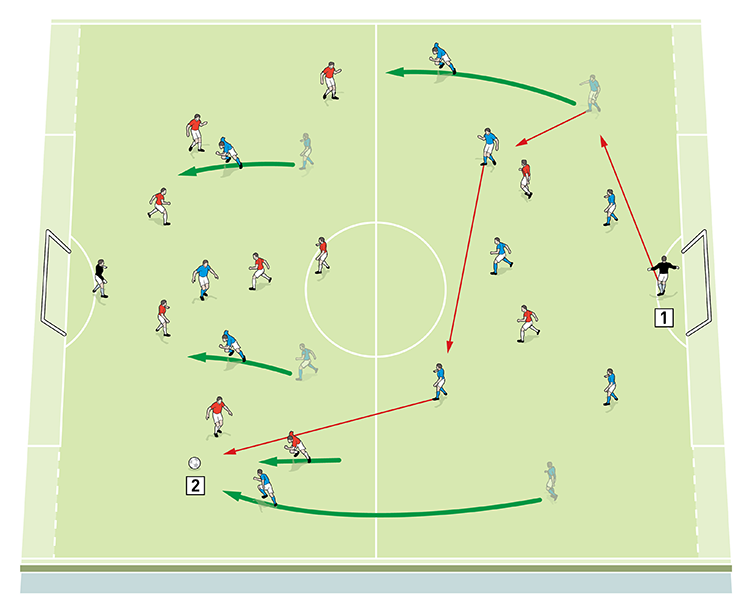You are viewing 1 of your 1 free articles
Switching play when counter-attacking
This session is all about changing the point of attack and switching play in counter-attacking situations. It will help the team get out of trouble when they’re being pressed, allowing them to turn pressured situations into quick counter-attacks.
| Area | Up to full pitch |
| Equipment | Balls, bibs, cones, 2 full size goals |
| No. of Players | Up to 22 players + 2 goalkeepers |
| Session Time |
Counter and switch: 20mins, Breakout and switch: 20mins, Box to box game: 20mins |
This session is all about changing the point of attack and switching play in counter-attacking situations. It will help the team get out of trouble when they’re being pressed, allowing them to turn pressured situations into quick counter-attacks.
To make this tactic effective, teams must be well organised when attacking. By repeating these practices, the ability to identify space in other areas of the pitch and switching the ball to these areas, will become like second nature to our players.
We would run this session if we were due to be playing against teams who control possession and dominate the play in attacking phases, or against teams that defend deep around their own area.
What do I get the players to do?
Counter and switch
We start the session with a 20-minute warm-up [not shown]. Then we set up on our normal pitch for the opening activity, with a goal and a goalkeeper at each end. We’re using 10 outfield players, divided into two teams of five. To replicate a counter-attacking situation, one team (the reds) starts with all its players in the penalty area they are defending and the other team (the blues) starts with three defenders on the edge of their own penalty box and two attackers outside the opposition penalty area.
The red goalkeeper starts play by passing out of the penalty area, as if launching a rapid counter-attack from the back, as shown [1a]. The players must then switch play to the other side of the pitch, as shown [1b], and they should try to fashion a goal-scoring opportunity, attacking 5v3 against the blues. Once a shot has been taken or the ball is dead, the teams should swap roles and reset. This time the blue goalkeeper starts play, launching a counter-attack in the other direction, as shown [1c].
1a

2. The blue team have two strikers starting on the edge of the opposition penalty area, who can try to hold up any counter-attack
3. After the red keeper passes out from the back, his team mates push up the pitch to receive the ball and support the counter-attack
1b

2. After the switch of play, the reds attack the blues in a 5v3 and try to score
1c

2. This time, the blue keeper starts play by launching a counter-attack from the back
3. Now the blues attack and must look to switch the ball to the other side of the pitch
We play for 20 minutes, with each team attacking five times on each flank.
What do I get the players to do next?
Breakout and switch
We set up on half a pitch, with a 20x20-yard square marked out in one corner, and a goal and a goalkeeper at the other end. We’re using 22 outfield players, split into an attacking team of 10 (the blues), a defending team of 10 (the reds), and two floaters (the yellows). Three blue attackers and three red defenders start in the 20-yard square, along with the two yellow floaters who play for the team in possession, while the remaining players start in the main area, set-up as shown [2].
2

2. If the red defenders win the ball in the square, they must make four passes and clear it out of the box to win a point
3. The blue attacking team must string four passes together in the square with the help of the yellows before passing to their team mate in the centre circle
4. The player in the centre circle must switch the ball to a wide player, who launches a counter-attack under pressure from the red defenders
The blue attacking team starts play with the ball in the square and they must make four passes without their opponents touching the ball before they can pass to their team mate in the centre circle. The attacking team must then switch play to their wide player and should try to create a goal-scoring opportunity. The defenders should try to stop them as normal.
If the red defending team wins the ball in the square, they must make four passes and then clear it out of the square to win a point.
We play for 20 minutes, with teams taking turns to be the attackers.
How would you put this into a game situation?
Box to box game
We set up between the two penalty boxes with a goal and a goalkeeper at each end. We’re using 20 outfield players split into two teams of 10. We play an 11v11 game with the one restriction that teams must switch play before they can attempt to score a goal, as shown [3].
3

2. Play a normal 11v11 game but teams must switch play before attempting to score
How do I progress the session?
We want players to be able to visualise their options for playing the long ball into much less congested areas of the pitch.
Once players have mastered this tactic, we can try to make the drills harder by reducing the number of touches allowed. We can progress it further by increasing the number of players in defence.
What are the key things to look for?
When teams are under pressure, we want to see players looking for options of superiority on the opposite flank. Players should make movements to create space in order to quickly counter-attack the opposition goal.
What are the typical mistakes players might make and how do I avoid them?
Errors in execution of the long ball when switching play can cause problems. This can only be corrected through repetition of the activities in this session.
Related Files
More like this
Editor's Picks
Intensive boxes drill with goals
Penetrating the final third
Creating and finishing
My philosophy
Pressing initiation
Compact team movement
Defensive organisation
Back three tactics
Counter-pressing as an offensive weapon
Coaches' Testimonials

Alan Pardew

Arsène Wenger

Brendan Rodgers

Carlos Carvalhal

José Mourinho

Jürgen Klopp

Pep Guardiola

Roy Hodgson

Sir Alex Ferguson

Steven Gerrard
Coaches' Testimonials

Gerald Kearney, Downtown Las Vegas Soccer Club

Paul Butler, Florida, USA

Rick Shields, Springboro, USA

Tony Green, Pierrefonds Titans, Quebec, Canada
Join the world's leading coaches and managers and discover for yourself one of the best kept secrets in coaching. No other training tool on the planet is written or read by the calibre of names you’ll find in Elite Soccer.
In a recent survey 92% of subscribers said Elite Soccer makes them more confident, 89% said it makes them a more effective coach and 91% said it makes them more inspired.
Get Monthly Inspiration
All the latest techniques and approaches
Since 2010 Elite Soccer has given subscribers exclusive insight into the training ground practices of the world’s best coaches. Published in partnership with the League Managers Association we have unparalleled access to the leading lights in the English leagues, as well as a host of international managers.
Elite Soccer exclusively features sessions written by the coaches themselves. There are no observed sessions and no sessions “in the style of”, just first-hand advice delivered direct to you from the coach.








